Ever wondered how to make perfectly cooked, crispy and delicious potato latkes? Having trouble getting your latkes to stick together and fry up light and crisp? This post and video will walk you through the whole process, with links to time-tested recipes that produce amazing latkes every time!
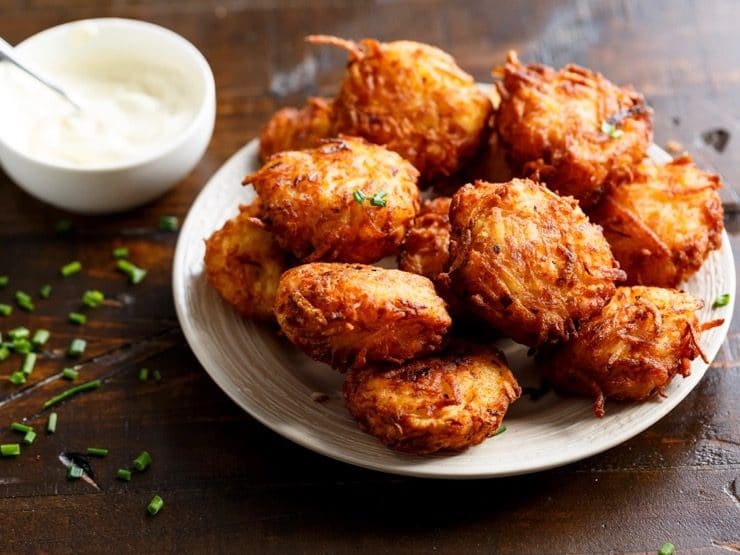
I celebrated my first Hanukkah several years before I converted to Judaism. I had studied Judaism in college, but I didn’t have any practical experience when it came to Jewish food or holiday traditions. Meanwhile, my husband-to-be was as Jewish as they come. He was born and raised in Israel by two Jewish parents and a rabbi grandfather. He grew up spinning dreidels and eating sufganiyot (Hanukkah jelly doughnuts). I grew up singing Christmas carols and hanging stockings by the chimney with care. My first attempt at cooking latkes was a minor disaster. Luckily, I’ve learned a thing or two since then. I thought it would be fun to put some of my most helpful tips into a post, so you can avoid the potato pancake pitfalls that I’ve experienced along the way.
This post will give you specific tips for making amazing crispy latkes. If you’re looking for recipes, scroll to the end of this post, where I’ve linked to some fabulous, time-tested options. Before we dive in, here are a few facts about latkes.
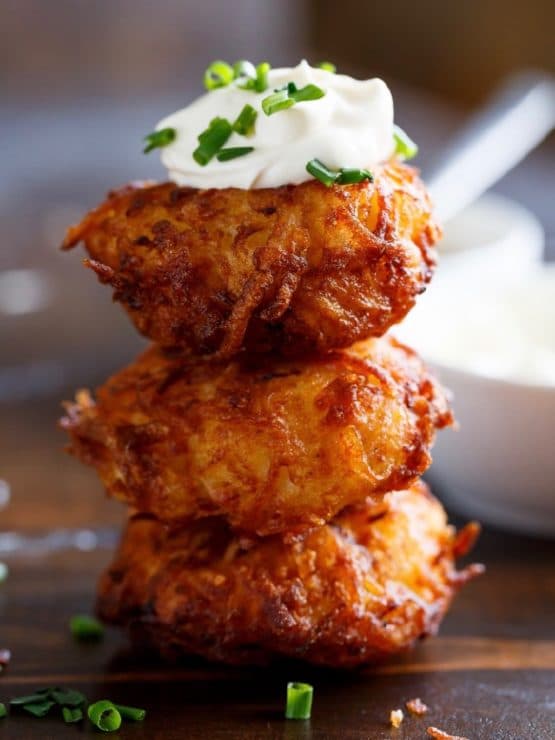
LATKE FACTS
– Latkes are traditionally cooked on Hanukkah, along with other fried foods, to commemorate the miracle of the menorah oil in the Jewish Temple (see my Hanukkah page for more details).
– Latkes are made from shredded potatoes, eggs, onions and salt. Matzo meal, flour or breadcrumbs are often added to help bind the ingredients together. Herbs and spices are sometimes added for flavor.
– Sephardic Jews traditionally fry their fritters (like bimuelos and keftes) in olive oil because Hanukkah occurs at the end of the olive-pressing season. Olive oil was treasured in Biblical times, so using it to fry latkes gives the dish a deeper significance. Ashkenazi Jews in Eastern Europe and immigrants to America typically fried their latkes in schmaltz, or rendered poultry fat, until more healthy oil alternatives were introduced. Some cooks still splurge and use schmaltz because it tastes so darned delectable.
– Chremslach (singular: chremsel) is the Yiddish word for a fried pancake. Potato chremslach are often mistaken for latkes. They are similar to latkes, with one major difference. Instead of shredding the potatoes, as we do with latkes, the potatoes are mashed and made into a thick batter before frying. Chremslach often appear on deli menus as “potato pancakes.” Latkes are thinner and more crispy due to the shredded texture of the potatoes. Chremslach are thicker and fluffier.
– Latkes are traditionally made from potatoes because they were plentiful and easy to obtain for Eastern European Jewish cooks. However, there is no law that says latkes have to be made from potatoes. They can also be made using shredded vegetables, sweet potatoes, or even cheese.
LATKE COOKING TIPS
Okay, now let’s dig into the nitty gritty details! If you’re in a hurry, this video will give you an overview of the process:
– You can shred your potatoes with either a hand grater or a food processor with a grating attachment. Some Jewish cooks swear by the hand grater, saying it makes a big difference in taste. Others revel in the convenience of the food processor. Neither method is “correct,” it’s simply a matter of preference. Using a food processor will cut your prep time dramatically, and will also be easier on your arms and shoulders. For an easier alternative, you can use the bagged hash brown shreds found in the refrigerated section of the grocery store. Last time I checked those products do not have a kosher hechsher (that may have changed though).
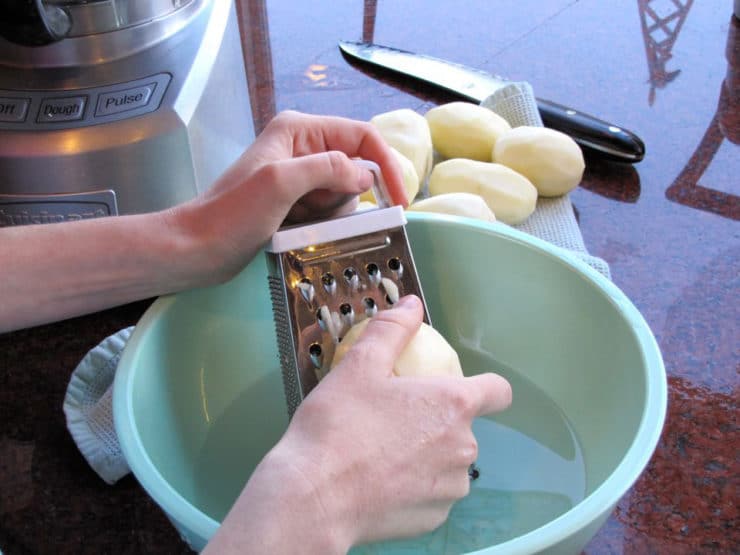
– Some cooks prefer using large shreds of potatoes, while some prefer a finer shred. My preference varies based on the recipe. Finer shreds tend to have a more hash brown-like texture. You can choose whatever texture works best for you.
– After shredding your potatoes, immerse them in cold water to keep them from discoloring. If you’re using a hand grater, you can shred them directly into the bowl of water. Soaking the shreds helps to keep them from turning brown; it also has the added benefit of making crispier latkes. I am not sure of the food science behind why this is, but it works!
– When you’re ready to prepare your latke mixture, drain the potatoes. If you drain the shreds slowly with the bowl tilted, you will see a cloudy white layer that has settled at the bottom of the soaking bowl. This is potato starch. Scrape this starch up and add it to the shreds after you’ve drained them, it will help to bind the latkes together. I often add additional dry potato starch to the shredded mixture (sold by the can at kosher stores year-round and everywhere during Passover) to make sure the latkes don’t fall apart during frying.
– Get as much liquid out of your potato shreds as possible before mixing in the egg and other stuff by wringing them out in a cheesecloth or a tea towel. The less moisture in the shreds, the better your results will be.
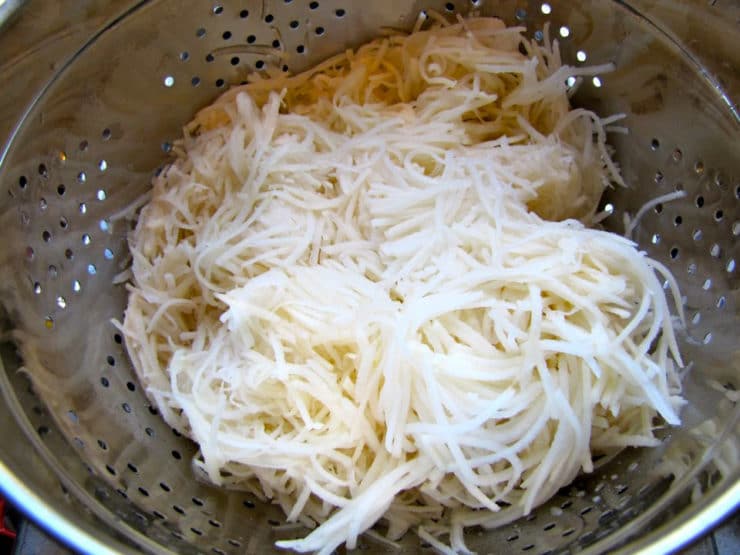
– When you’re ready to fry, have a draining/drying rack set up close by with a layer of paper towels underneath. This is where the latkes should drain from the hot oil. I prefer draining them on a rack rather than directly on paper towels, I find they stay more crisp that way.
– The ideal temperature to fry a latke is between 360 and 375 degrees F. The best way to monitor the temperature is to use a deep fry or candy thermometer. If you don’t have one of those, here are two simple methods to test the oil’s temperature:
Drop a small piece of bread into the oil. If it takes 60 seconds to brown, the oil temperature is perfect for frying.
Place a kernel of unpopped popcorn into the oil. When the kernel pops, the oil is hot enough to fry.
Once you’ve fried several batches of latkes you’ll get a feel for how hot the oil needs to be and you won’t need to test it anymore.
– Form your latke mixture into compact patties. I generally use about 3 tablespoons of potato shred mixture per latke, depending on the recipe. I’ve found that this amount makes small/medium sized latkes that fry up extra crispy.
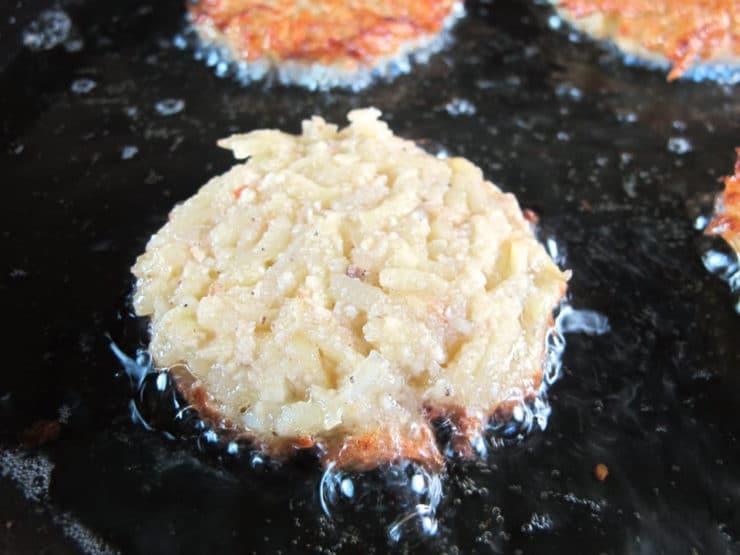
– Start with a “test” latke to determine if the oil is at the right temperature. The latke should take about 2-3 minutes per side to become brown and crisp. If it takes longer than that, the oil is to cold. If it fries faster than that, the oil is too hot. Once you’re happy with your test latke and the oil temp, you’re ready to fry.
– Fry the latkes in small batches. 4-5 at a time in a large skillet works best. Trying to cook too many at one time crowds the pan and makes the temperature of the oil drop, which will result in soggy latkes. Flip them when you see the bottom turning golden brown around the edges. Give them adequate time to brown– the less you flip latkes the better.
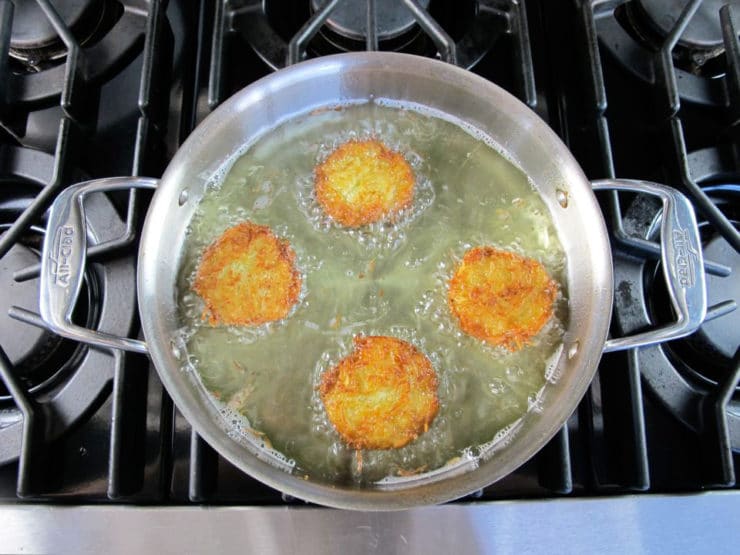
– If your latkes aren’t holding together, stir more potato starch into the mixture, 2 teaspoons at a time, till the batter “holds.” You can also add another egg to the mixture and more flour or breadcrumbs, if needed.
– While olive oil and schmaltz are both traditionally used to cook latkes, they are not necessarily the best choice for modern cooks. Olive oil has a somewhat low smoke point, which means the oil can burn and discolor if it’s kept at a high frying temperature for a long period of time. Schmaltz is delicious, but it’s full of cholesterol. I prefer to cook my latkes in peanut or grapeseed oil, both of which have higher smoke points. Grapeseed is a healthier oil with no cholesterol, while peanut oil is great for frying and adds flavor to the latkes. No matter which oil I use, I like to melt a little schmaltz in to boost the savory flavor. You can purchase schmaltz or make your own – click here for the recipe.
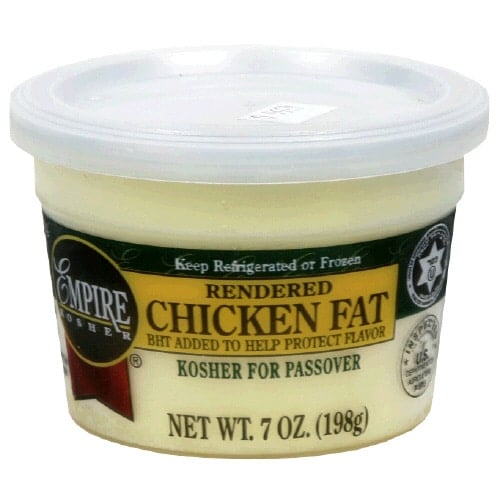
– Always serve latkes hot and fresh if possible. The longer they sit, the less crisp they’ll be.
– If you must make your latkes ahead, fry them 4 hours or less before serving. After allowing the latkes to drain on the wire cooling rack, place them on an ungreased, unlined cookie sheet. When ready to reheat, place in a 375 degree oven for about 10 minutes (7 if using a convection oven) until heated through just prior to serving. A convection oven setting will produce a more crispy result.
– Latkes always taste best just after they’re fried, but serving them fresh is not always a possibility, especially when you’re cooking for a large group. My friend Denise Vivaldo, a chef and food stylist, has made latkes for large catering groups (we’re talking 5,000 latkes in one sitting!). She freezes them until ready to serve, then uses a convection oven to reheat. The dry, circulating heat of a convection oven keeps the latkes crisp and fresh. You would be wise to take Denise’s advice; she’s catered the Academy Awards and cooked for presidents and royalty, so she knows a thing or two about great food!
– To store frozen latkes, fry them and drain the oil, then place them in single layers separated by wax or parchment paper in an airtight sealed freezer bag or Tupperware. When ready to reheat, place them straight from the freezer onto ungreased cookie sheets and cook them 400 degrees F for 10-15 minutes till heated through and crisp (convection oven is best). You can also line the cookie sheets with brown paper to help soak up some of the excess oil. Never refrigerate latkes, it makes them mushy.
– Latkes can be served with applesauce or sour cream, or both. Some folks top their latkes with smoked salmon or caviar. Often non-dairy sour cream is used to avoid mixing dairy and meat at a kosher meal. Try serving latkes with Greek yogurt for a healthier alternative.
RECIPES
Okay, ready to make some latkes? Here are some great latke recipes (and related potato pancake recipes) to try!
Gluten Free Crispy Yukon Gold Latkes
Sweet Potato Latkes with Brown Sugar Syrup
Sweet Potato Coconut Chremslach
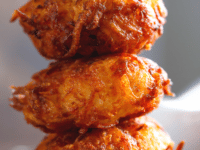
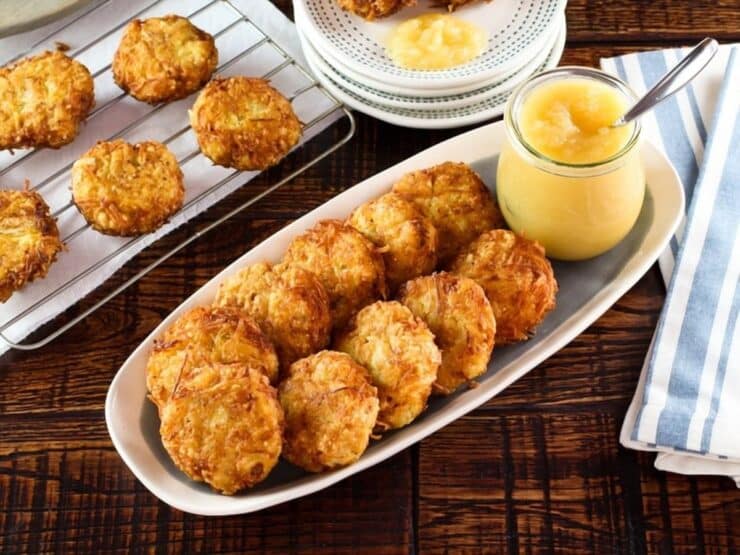
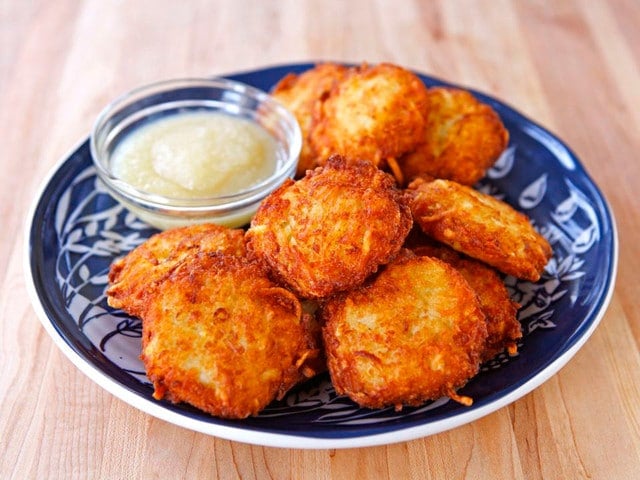
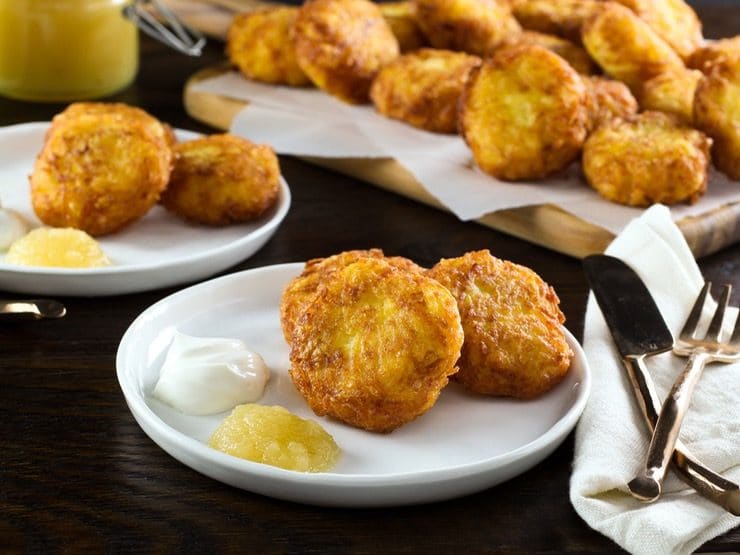
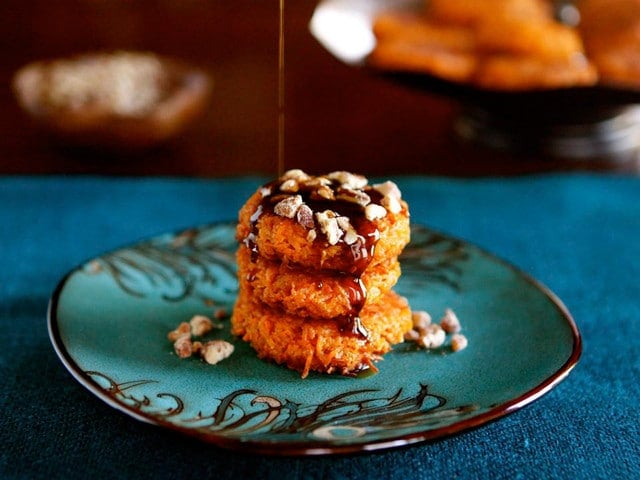
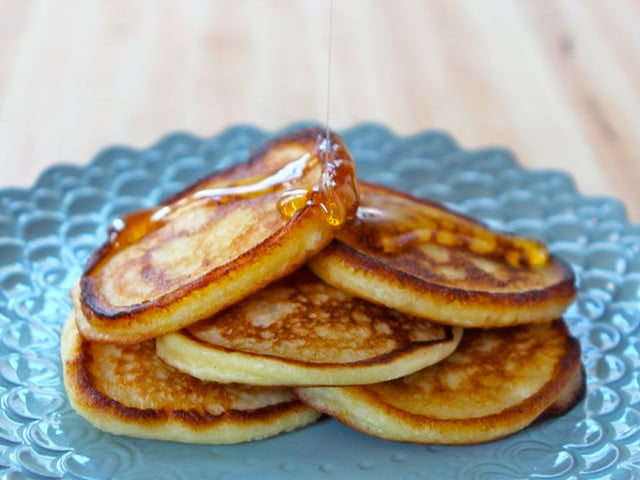
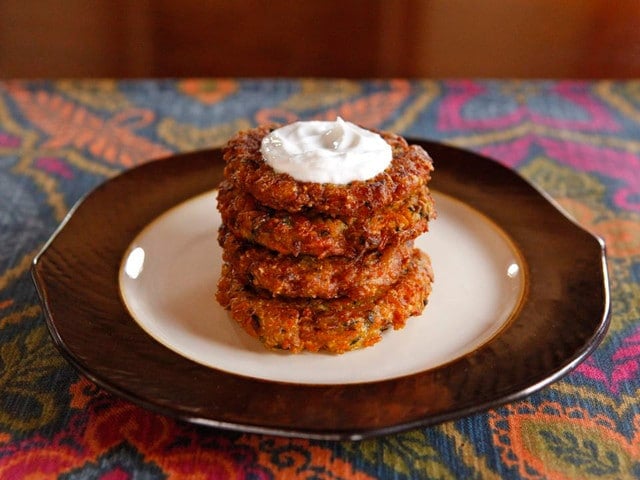
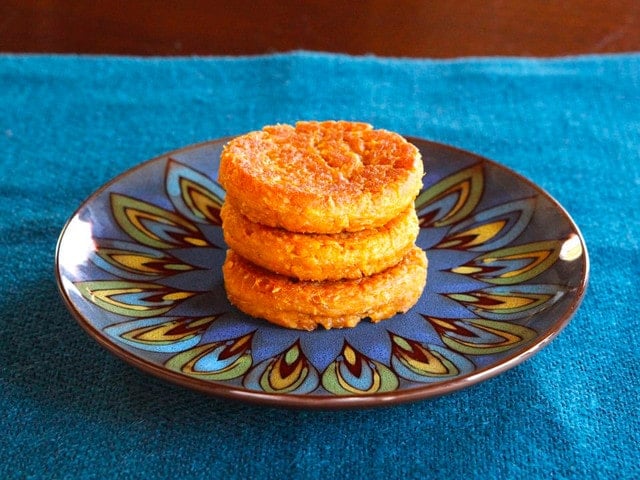


I’m also a convert and I love to learn from you what my mother could not teach me. Thank you!
Happy Chanukah to everybody.
I don’t have any potato starch and never use it. Your video says that I can use the starch from the bowl and then add also dry to the mixture. Can I just double the amount of liquid starch to make up for the lack of dry starch will that be too much?
Would cornstarch be OK instead of the potato starch.. would it make a difference?
You can use cornstarch, and all of the liquid starch from the bowl.
Thank you Tori— they’re grated and ready to fry….
Here is my easiest latke recipe:
one box of Homestyle potato Pancake Mix: Mix according to directions on box. Add refrigerated (a large handful) of shredded potatoes, not frozen ones! Combine and makes a lot of latkes. Fry in hot oil in frying pan. Press each down with the back of a soup spoon to get them thin and crispy! Flash freeze on a cookie sheet and then place in a plastic bag to freeze. Heat frozen in a hot oven. So delish!
Exactly matches my recipe thanks so
Much for the detailed explanation. On food processor vs hand grating, my dad would say that hand grating adds the secret ingredient- the blood of The cook. ???
I need a good recipe for Vegan Latkes, help please
Monica, I am working to develop one as we speak! Hope to post it this week. 🙂
Hi Tori,
Since the goal is to remove as much water as possible, it seems counter-intuitive to soak them in water as it would require much more squeezing to get them dry.… Is the only reason for the soak to keep them from browning?
Hi Janet – no, actually. This is a tip I learned many, many years ago from a family friend. Whenever I soak the shreds, the result is a lighter, fluffier, crispier latke. I don’t 100% understand the science behind it, but I will say I have tried it without soaking and with, and the soaked shreds always produce better, crispier latkes. So that’s what I recommend. 🙂
The potato shreds are not absorbent. You are removing the surface liquid and gelatinous material from the cells ripped open during the shredding process. You are also keeping oxygen from the surface of the potato thereby keeping it nice and white and preventing slime from forming. You can even gently agitate the mix under the cold water with your clean fingers to make them even dryer!
Jerry, thank you for this elegant explanation! 🙂
I have been looking for a simple recipe, and yours by far is the closest to my Ex-Mother-in laws. Schmaltz is something I will have to acquire for next time like Peanut oil (we deep fried Turkeys and wings with)
I wonder if you have a recipe for Livayadka soup?
Keep it Kosher
Le’Hiam
Made these last night. Came out perfect. Recommend using to spatulas to turn. Wanted to post a pic. But I posted on IG: #christophers_kitchen . Thank you.
Today is the first day I saw your potato Latkas. I will be trying them
To make them. Thank you for putting up the recipe.
these look so delicious, I think I’m going to make the soon too! Thanks for sharing 🙂
My husband, who is Thai, hand grated the potatoes and I made them based on some of the recipes I found on the Web, which included baking powder. The potatoes were ground to fine and overall they were truly terrible. We still had a yen for latkes, so I decided to make them roughly the way my mother did, but using a great food processor instead of hand grating and sans baking powder. I prefer the grated kind, shreds seem to be a more recent addition. I processed the potatoes and onion roughly. Then drained the water out into a bowl using a large strainer. I poured the water out, but saved the starch. I put the potatoes into the bowl, added 2/3 cup of matza meal, 2 beaten eggs, salt and pepper. I prefer to fry in peanut oil and would have added some duck fat, had I found your blog earlier. They were perfect, fried to a golden brown and topped with a good quality yogurt and apple sauce. We just couldn’t stop eating them, so I doubt that there’ll be any left to freeze. You recipe came the closest to my Mom’s except that you shredded the potatoes. I use recipes to get ideas, but when I start to actually cook, I usually just go by gut feeling and ancient memories. I will look up your blog again. Thank you.
Glad you found a combination that works for you Dina!
I have been making latkes for decades. Both my grandmother and mother-in-law never drained the mixture and often mixed the settled liquid/potato starch back in during cooking. This resulted in a great deal of spattering; water in hot oil. I made latkes again yesterday following your recommendation of draining and squeezing out the liquid. Voila, no spattering, they held together much better, recovered most of the potato starch, and best of all, they tasted just like grandma’s.
There is a method to my madness. 🙂 So happy you enjoyed them!
do you have a recipe for vegan latkes.
Hi Bonnie! I do but I haven’t posted it yet. I do have this which is very close to a latke but it’s baked instead of fried, and it is vegan: https://toriavey.com/toris-kitchen/kartoffelpuffer-potato-tahini-patties/
I love your recipe however you should never rinse your shredded potatoes as it gets rid of the starch, even if you are trying to add it back in. That’s not the traditional way of making latkes.
Hi Sherri– actually, I’ve found that soaking and draining the shreds makes for a crispier end texture. Without soaking, draining, and squeezing dry, the latke shreds retain too much of their own starchy moisture and the hot oil splatters a lot as they cook– also, the inner latke doesn’t cook up as light and fluffy. This is from years of experimentation, you certainly don’t have to do it that way but it’s the way I prefer to make it. Every family has different traditions! 🙂
Shred the potatoes, drain the liquid, then add the egg and other stuff. What’s the other stuff? Seems like a step is missing.
Hi Jason– this is a list of steps to help make great latkes using any recipe. However, they are just tips. You will need an actual recipe to follow. I have linked to several recipes in this post that work well.
Can I use Streits Potato Pancake mix? Is that the same a matzo meal? TIA!
Stephanie– no, the potato pancake mix contains dehydrated potato powder, which is not needed for this recipe. Matzo meal can be used, or breadcrumbs, or even panko breadcrumbs (my personal favorite). Follow one of the recipe links above for best results… I really love the Crispy Panko Potato Latke recipe myself. 🙂
Just made the Latkas, added some cheese, they were very crisp n too delicious. Thanks for the amazing recipe.
nowhere have i seen how much of anything to make.
i can guess it.
William– if you scroll up to the pictures of the latkes, they link to recipes. 🙂
Hiya Tori! 🙂
You mentioned freezing them after frying but I’m wondering how long the Latke mixture will keep. Does it need to be used right away or could it be kept for a day or two?
Hi Shane – I do not recommend freezing raw latke mixture. In my experience freezing this type of mixture makes it go grey in color and messes with the texture, making it totally unappealing. Better to make the latkes, then freeze.
I just made latkes with your recipe and they’re as crispy as you promised they’d be !! I’m exhilarated!